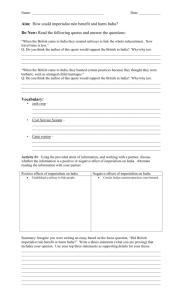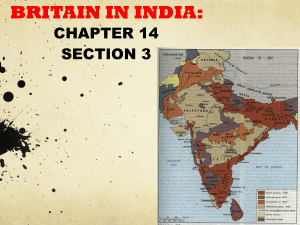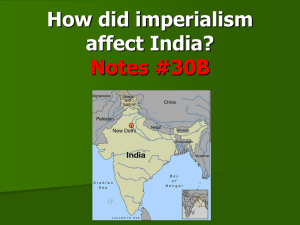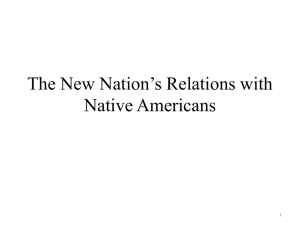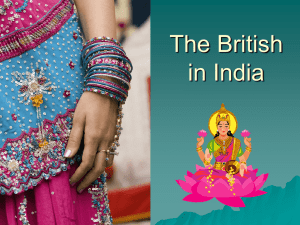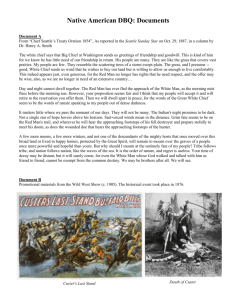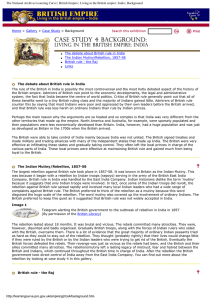British Imperialism in India - Imperialsm-by
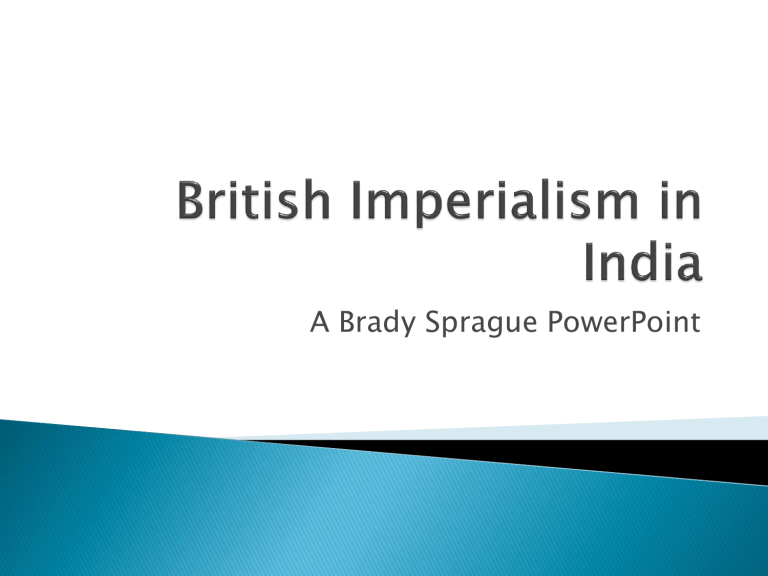
A Brady Sprague PowerPoint
Advantages of Imperialism
Disadvantages of Imperialism
Overall Effects of Imperialism
Western Powers Involved
Indigenous Response
Results of Independence
British Economic gain from Tea and cotton exports, makes India “the jewel of the crown”
Indian rail system and telegraph lines constructed, largest in Asia, 5 th in the world.
Widow Burning, Slavery, Female Infanticide and
Widow remarriage prohibitions outlawed
Sewage systems and filtered water dramatically reduce cholera spread by rail
British reform produces many jobs and increases trade
Sovereignty of Indian princes and Muslim Holy men kept under the British Raj
Racism rampant, British looked down upon the Indians that they ruled over
Cholera grows into an epidemic after the construction of the railroads, later solved
Indians lose real power over themselves, forced to work on British plantations (not as slaves, however)
Cultural difficulties, conflicting traditions between British and Indian peoples
Rapid expansion of British and Indian economies
Modernization of transportation, sanitation and communication in India
Powerful and efficient Indian central government
By 1818 Britain controls an empire with a population greater than that of western
Europe and 50 times that they lost in North
America
Disgruntled traditionalist Indians
British East India company founded in 1600
Old Mughal states were ruled by Nawabs, or
Muslim Princes
The Raj was Britain's rule over the subcontinent of India
European companies took control by forming large mercenary armies of Sepoys, or trained
Indians
The French were stymied by the British in
1763
The Dutch East India company was dissolved in 1795
Great Britain held a monopoly on the entire subcontinent of India
British companies ruled directly over their workers and land, while British government officials oversaw the Bureaucracy (direct rule)
There were constant rebellions throughout
India, requiring the British to keep a large military presence and Sepoy force
Sepoy Mutiny of 1857 occurs, the first nearly successful revolt against British rule by
Indians
Most work for British companies, on British plantations but maintain traditional lives at home
Rammohum Roy founds the Brahmo Samaj in
1828, seeks to reconcile western values with
Hindu traditions
Roy helps found the Hindu college in Calcutta in 1816
First Indian woman school opens in 1849
New nationalists from the Indian Middle Class emerge, forming the Indian National
Congress in 1885
Independence from Great Britain was not free for Indians
Independence movement led by the Indian
National Congress and other organizations
Mahatma Ghandi led millions in campaigns of non-violent civil disobedience
On the 15 th of August 1947, India gained independence from British rule
Muslim-majority areas were partitioned to form a separate state of Pakistan. On the 26 th of January 1950, India became a republic and a new constitution came into effect
Today, India has one of the worlds fastest growing economies and is a nuclear power
Many of today’s top universities are located in
India
